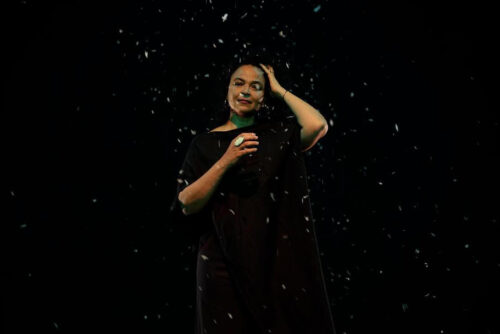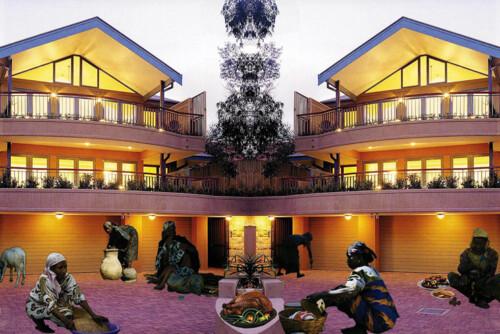A Duration of Care, 2023. Video by Sumedha Bhattacharyya.
I/m/age/ing: A Provocation to Contemplate Aging in Dance in the Indian Context
Written in 2020, revised in 2023
I was twenty-seven years old when I started writing this essay. A year before, overnight, my mother and I became caregivers to my father. This year, I will be turning thirty. I can feel I am aging. I live in India. I was trained in Kathak, one of the eight major forms of Indian classical dance. In recent years, I moved to contemporary dance and dance filmmaking. I have relied on my body all my life. But over the years, after recovering twice from COVID and through the caregiving of my father, my body became different. Never have I felt such inability and insecurity doing simple tasks like getting out of bed, or simply moving and dancing, than during and since my recovery from COVID and the exhaustion that has endured. I feel a constant desire and longing to go back to a previously lived version of this body than the one that lives today.
*
When I think of aging, many images appear in my mind. When put into words, the images lead me along a linear way of understanding bodies in time. Unavoidably, these images lead to ruminations on longevity, mortality, and death, and on to discomfort in conversation with friends, family, colleagues, and even with myself. Has the image of myself changed, or is it the experience? I write this essay as a provocation and space for contemplation to understand aging in my socio-cultural and political context in India.
*
In our present time defined by a pandemic, with the global inequity of vaccination, I wonder what is changing in the ways we think about aging and mortality? Are we witnessing a sharpening of divides between who will live and who will die, a starkness like the haves and have-nots? Are we becoming more fearful and hateful towards our depleting life expectancies as humans—and towards each other, towards ourselves? Playwright Jean-Claude van Itallie writes, “Our society denies death to the point of inconceivability, and views aging with the same shame as defecation.”1
*
Aging is not an object in a vacuum. Like space, it is not a transparent and innocent entity. It is imbued with power. As an interdisciplinary dance artist trained in one of the eight Indian classical forms, Kathak, and as an educator, researcher, and primary caregiver, where do I begin to unpack aging?
*
I see aging each day as a primary caregiver to a parent. Most days, my feelings come down to a wish not to have to see the day when my body reaches an inability to move, like his. When my father suffered a stroke, I felt a drastic change in my way of looking at life, embracing grief and everyday decay on the one hand, and gratitude, seeing him alive, living with us, with a renewed sense of life through this period on the other. This was the first time I felt the emotional flux of longing and perhaps nostalgia toward aging in my everyday being as a daughter first, woman next, and finally a woman dancer and dance-filmmaker. This was the first time I felt able to approach sensitive topics in my artistic practice that are often neglected and ignored. Is it out of convenience or do we somehow develop a forced amnesia towards them? I felt a wish to mature, experience, and involve in my dance and film practice a sensibility of care that comes from embracing different kinds of ability, slowness, and acceptance. In movement, there is a before and after. This embrace of time has become part of my dance and film practice.
*
As a Kathak dancer, I was trained not just to dance but to see. At countless performances, I watched dancers with bodies I came to desire. My training prescribed binary notions of beauty and demanded that my body become its ideal container. The image of beauty, of being a female dancer dancing, materialized in an able body, young, and slim.
I spent my childhood watching Bollywood films as well. The stories are set within multiple and massive choreographed song and dance sequences. The women dancers become the objects of desire mediated by the camera’s eye. We perceive what our eyes see and are trained to see. My eyes are trained to see beautiful, young bodies dancing and to value them. My eyes are also trained to see aged bodies, exaggerated and, I would say, beautiful, with black hair and intense makeup. Yet as the American dancer, choreographer, and filmmaker Yvonne Rainer teaches us, representations of the aging body do not guide us toward seeing them as objects of desire, but rather disdain. Aging bodies remind us of death. Mature dancers are parodied, invisiblized, or dismissed.
When I trained to perform Kathak, I trained to be a certain kind of body for the audience to desire. It was my time, my peak, I was told.
*
The thought to work on this theme has been on my mind, however vainly, along with a feeling of unapproachable distance from senior dancers, practitioners, artist-researchers, and academics. When I try to approach, I feel their returned gaze and I fear being judged. From our childhood, in which grows within us our political and social context, we are taught, Respect your elders. If someone aged comes home, automatically our spines move into genuflection. We touch their feet, both, and we do a Pranam, a gesture to seek blessing, to devote, even if we do not feel it internally. On the outside, we are expected to present our respect, very much akin to the act of praying.
As I reflect back, the figure or the image of the Guru has been important in my practice. By contrast, in many cultures, seniors are authoritative, held in honor and respected for their experience and knowledge. But this can also create social and political problems. Paradoxically, the aging body-image for Guru does not shift as she is always in a position of power and privilege.
I trained under Guru Shishya Parampara. I looked up to her as a godlike figure. The all-seeing nature of Guru Shishya Parampara was inherent to our dance practice. We sought to story-tell about the Gods, the all-seeing eyes.
*
Aging is a paradox in dance, especially in the Indian context. On one the one hand, my own youth offers me a space to look up to someone for their knowledge, wisdom, and experience in the art. On the other hand, it positions me above them in practice. This does not adequately address or embrace the act of aging. I am left floating uncomfortably with denial, avoiding the taboo of aging, wondering, What will they think? Will they think, I am old, and that is why you came to me? Who likes to be called old? How do I ask them? How do I build trust so that they open up about aging?
*
I first saw the film ALL (2017) in 2019 at the Chicago International Film Festival in India. It left me emotional, teary-eyed, yet hopeful about intergenerational work. ALL, a dance film, was produced and co-choreographed by Amy Wilkinson based on research that explored the concept of home with a diverse cast, including several dancers with Parkinson’s disease. Not long after, I screened the film when I taught a guest session on creative expression with eight graders at the American Embassy School in India. When the film ended, I asked the children to write words or phrases to share their reflections.
Memory
Regret
Nostalgia
Mapping memories
Home as an idea that we carry in our hearts
Space keeps changing
In these words, I felt the first seeds stirring to create a dance film with my father and mother. What if what I was trained to think of as limitations and loss was actually a possibility for intergenerational creation?
*
A Duration of Care is a work-in-progress video and experiment with my mother and partner-in-caregiving for my father.
My mother was my first Guru in Kathak. She is the reason I began to see and learn dance. A few days before the filming, we watched Pina (2011), a film directed by Wim Wenders about dancer and choreographer Pina Bausch. My mother was amazed at seeing the possibilities of dance. She said to me “All this can also be considered dance?” The film made it easier for me to talk to her about aging. I told her about this essay. I read the first draft to her. The film and then a conversation on this writing paved the way for me to approach her directly. When we filmed, I gave her some prompts. How do you think through the lens of caregiving? What do you think of aging, not about it?
In response, she got up and made kadha, a traditional Indian immunity drink made of fennel seeds, lemon, ajwain, ginger, as she does, ritualistically, every morning for herself and the family. She showed me that aging and care are not single, defined entities in a given time. For her, the arrhythmic duration of caregiving, a hopeful mode of living, and the continuous act of fighting towards mortality, are what interest her. This video tries to bring an alternative and subversive reading to moving and aging bodies on a continuum of transformation.
*
Aging remains a sensitive topic. It takes trust and time to explicitly talk about it. Today, can most of us approach our seniors, our Gurus, and speak openly about aging? Will the discussion be reduced to the fact that aging is painful, that the dancer has just a few years to leave her mark? How do we keep open the possibility in aging? How do we creatively challenge the preceding images of aging?
Works Cited
Bhattacharyya, Sumedha. “A Duration of Care.” 2023. 2:48 min.
Gough, Richard, and Nanako Nakajima. “On Ageing (& Beyond).” Performance Research 24, no. 3 (2019): 1–8. doi:10.1080/13528165.2019.1655324
Marranca, Bonnie, Meredith Monk, Richard Foreman, Carolee Schneemann, Maria Irene Fornés, Deborah Jowitt, Deborah Hay, et al. “Ages of the Avant-Garde.” Performing Arts Journal 16, no. 1 (1994): 9–57. https://doi.org/10.2307/3245826.
Nakajima, Nanako. “De-Aging Dancerism? The Aging Body in Contemporary and Community Dance.” Performance Research 16, no. 3 (2011): 100–104. https://doi.org/10.1080/13528165.2011.606033.?
Schwaiger, Liz. “Performing One’s Age: Cultural Constructions of Aging and Embodiment in Western Theatrical Dancers.” Dance Research Journal 37, no. 1 (2005): 107–20. https://doi.org/10.2307/20444622.
Wilkinson, Amy. ALL. 2017. Film.
- Jean-Claude Van Itallie, “Ages of the Avant-Garde.” Performing Arts Journal 16, no. 1 (1994): 35. [↩]




